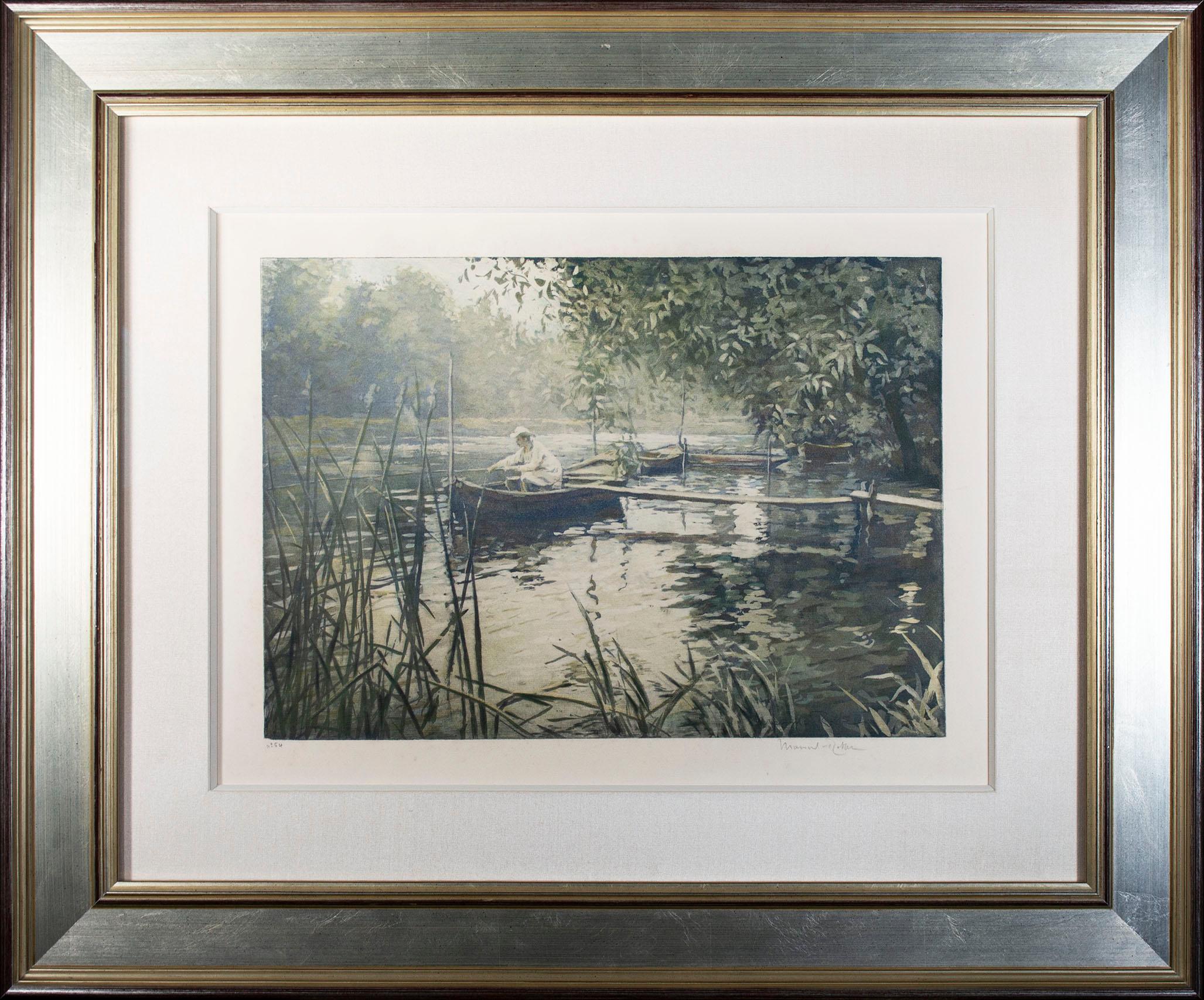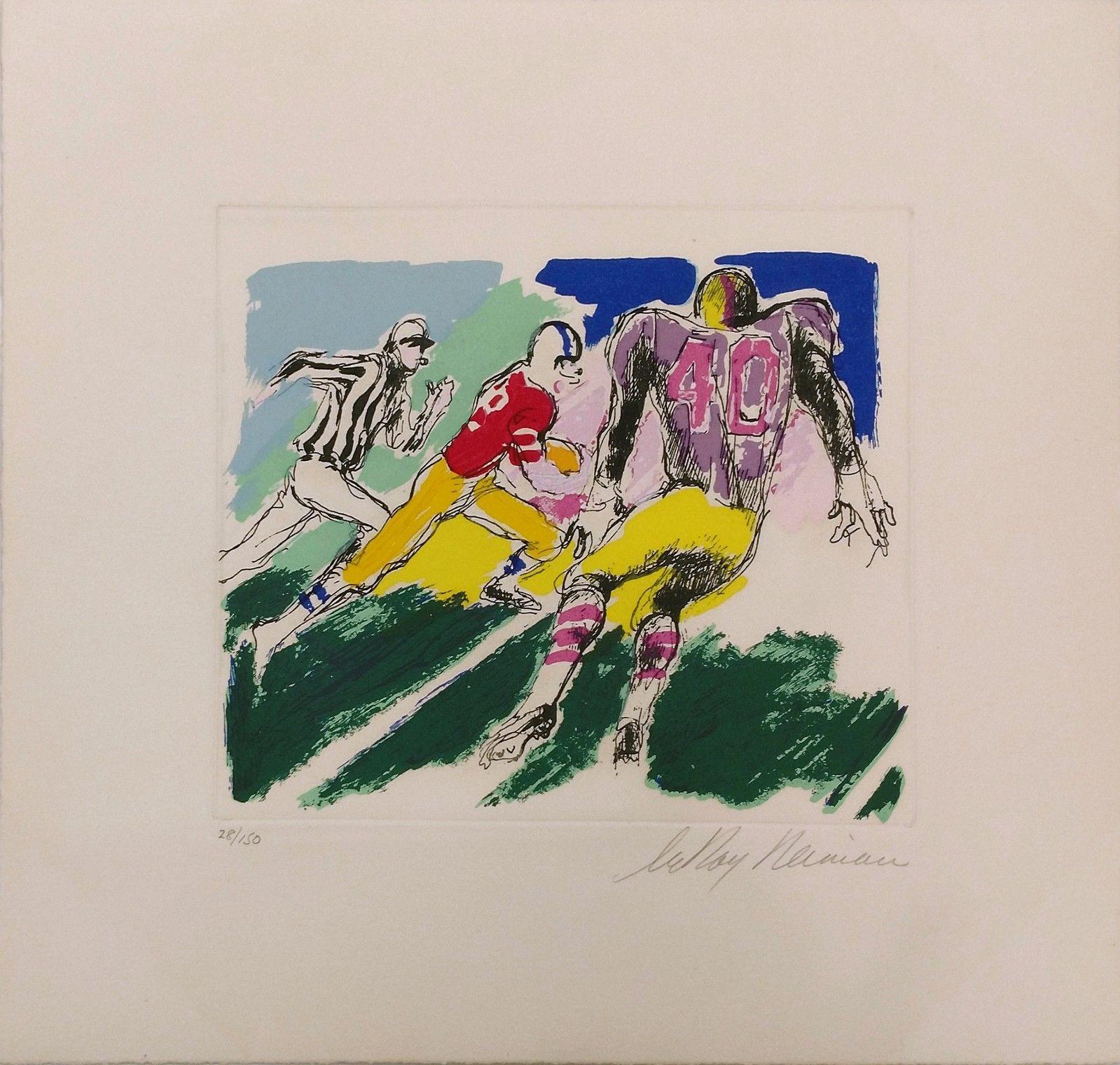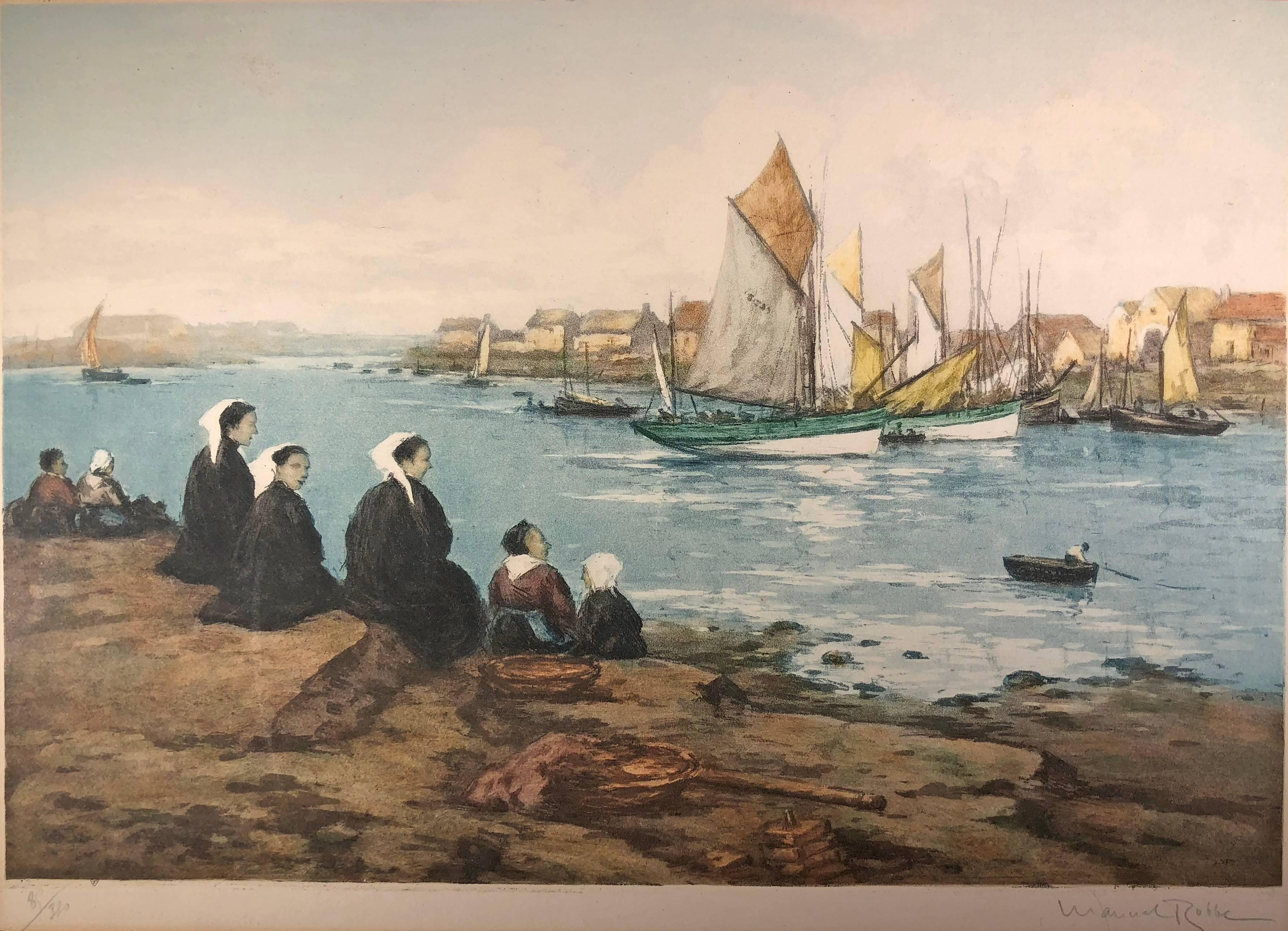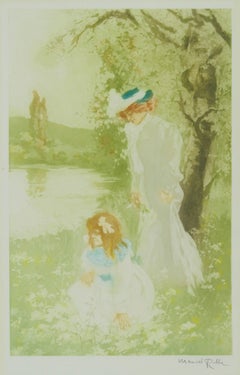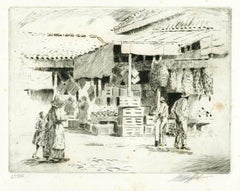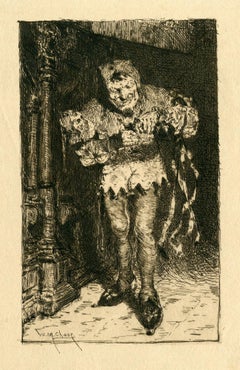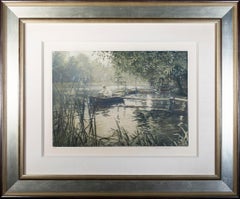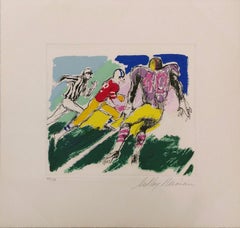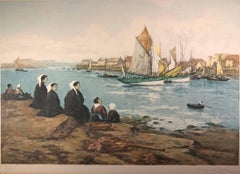Items Similar to A la Corrida
Want more images or videos?
Request additional images or videos from the seller
1 of 10
Allan Erik August OsterlindA la Corridac. 1900
c. 1900
About the Item
A la Corrida
Color aquatint, c. 1900
Signed "Osterlind" lower right in red pencil
Annotated: "No. 96" in pencil lower left
Edition: about 100
Published by Sagot, Paris: their blindstamp lower right
Image/plate size: 27 3/8 x 19 1/4 inches
Sheet size: 31 1/8 x 23 3/4 inches
Condition: Very good, one small (repaired tear in the right margin, not affecting the image
Erik Allan August Österlind (2 November 1855, Stockholm - 23 June 1938, Juvisy-sur-Orge) was a Swedish painter and engraver who spent most of life in France.
Biography
The Pied Piper of Hamelin
He was born to a family of the Swedish nobility and his father was a wholesale merchant. From 1874 to 1875, he studied at the Royal Swedish Academy of Fine Arts. As many young Swedish artist did, he went to Paris in 1877 so he could establish his career by exhibiting in the various salons. He soon became a member of the Swedish community there and became a lifelong friend of the painter, Ernst Josephson. He also became acquainted with Ville Vallgren, Christian Skredsvig, August Strindberg and Prince Eugen.
In 1878, he enrolled at the École des beaux-arts de Paris to study sculpture with Pierre-Jules Cavelier, who recommended that he become a painter and illustrator instead. From 1879, he was a frequent visitor to the artists' colonies at Barbizon and Grez-sur-Loing. Over the next decade, he gave several exhibits of watercolors and portraits, often with dark undertones. He also made visits to Brittany and Creuse, which became one of his favorite places.
In 1884 he, Josephson and Richard Bergh held a joint showing in Stockholm and, two years later, in Gothenburg. The following year, he became a signatory to an anti-Academy manifesto issued by a group known as the "Opponenterna [sv]". Despite opposition from King Oscar II, he and other Swedish expatriates participated in the Exposition Universelle (1889), and he was awarded a silver medal.
That same year, he married Joséphine Eugénie Carré (1862-1916), thereby legitimizing their two children, Anna Alina (born 1882) and Anders, who would also become a painter. As a result, he remained in France for the rest of his life, although he never gave up his connections to Sweden and maintained a regular correspondence with Prince Eugen..
In 1890, he ceased participating in showings at the regular salons and became a member of the Société nationale des beaux-arts, which began having annual exhibitions that year. Three years later, possibly at the urging of Josephson, he travelled throughout Andalusia, making sketches that would later become watercolors. In 1894, he was named a Chevalier in the Legion of Honour. In 1900, he founded an association of watercolorists and began creating aquatints.
The start of World War I and the death of his wife two years later left him in a state of depression and he spent more time travelling. He also began a curious collection of portrait paintings of the inhabitants of the Île-de-Bréhat, done on glasses and plates, at a local cabaret called the "Café des Pêcheurs". Apparently, unable to pay his bill, he had painted a portrait of himself as compensation. Several artists followed suit and the Café became known as the "Cabaret des Décapités". Some of them may still be seen at the Verrerie.
He died in poverty in 1938. His works may be seen at the Nationalmuseum, the Musée des beaux-arts de Tours, Musée des beaux-arts de Reims and several others in France and Sweden."
Courtesy Wikipedia
- Creator:Allan Erik August Osterlind (1855 - 1938)
- Creation Year:c. 1900
- Dimensions:Height: 31.125 in (79.06 cm)Width: 23.75 in (60.33 cm)
- Medium:
- Movement & Style:
- Period:
- Condition:
- Gallery Location:Fairlawn, OH
- Reference Number:Seller: FA48901stDibs: LU14013572872
About the Seller
5.0
Recognized Seller
These prestigious sellers are industry leaders and represent the highest echelon for item quality and design.
Platinum Seller
Premium sellers with a 4.7+ rating and 24-hour response times
Established in 1978
1stDibs seller since 2013
785 sales on 1stDibs
Typical response time: <1 hour
Associations
International Fine Print Dealers Association
- ShippingRetrieving quote...Shipping from: Fairlawn, OH
- Return Policy
Authenticity Guarantee
In the unlikely event there’s an issue with an item’s authenticity, contact us within 1 year for a full refund. DetailsMoney-Back Guarantee
If your item is not as described, is damaged in transit, or does not arrive, contact us within 7 days for a full refund. Details24-Hour Cancellation
You have a 24-hour grace period in which to reconsider your purchase, with no questions asked.Vetted Professional Sellers
Our world-class sellers must adhere to strict standards for service and quality, maintaining the integrity of our listings.Price-Match Guarantee
If you find that a seller listed the same item for a lower price elsewhere, we’ll match it.Trusted Global Delivery
Our best-in-class carrier network provides specialized shipping options worldwide, including custom delivery.More From This Seller
View AllAvril
By Manuel Robbe
Located in Fairlawn, OH
Avril (April)
Color aquatint and etching, c. 1906
Signed in pencil lower right
Edition: c. 100
Excellent impression, fresh colors
Reference: Merrill Chase Volume 1, No. 9
Condition: ...
Category
Early 1900s Impressionist Figurative Prints
Materials
Aquatint
Noon Time Lull (Charleston, South Carolina)
By Louis Oscar Griffith
Located in Fairlawn, OH
Noon Time Lull (Charleston, South Carolina)
Etching, c. 1930
Signed by the artist in pencil lower right (see photo)
Note: An image done in South Carolina.
An impression of this image...
Category
1930s American Impressionist Figurative Prints
Materials
Etching
L'enfant prodigue: en pays etranger (The Prodigal Son: In Foreign Climes)
By James Jacques Joseph Tissot
Located in Fairlawn, OH
L'enfant prodigue: en pays etranger (The Prodigal Son: In Foreign Climes)
Etching, 1881
Unsigned (as usual for this state)
From: L'enfant prodigue, (The Prodigal Son, five plates)
Ed...
Category
1880s Impressionist Figurative Prints
Materials
Etching
Keying Up - The Court Jester
By William Merritt Chase
Located in Fairlawn, OH
Keying Up - The Court Jester
Etching with drypoint, 1879
Signed in the plate lower left corner (see photos)
Proof before engraved title and engraved names
Printed on thin light golden Japanese tissue paper
In the final state, with engraved titled and typeface engraved artist’s signature below the image
Condition: excellent
Plate size: 6-5/8 x 4-1/4"
According to Pisano, this image was very popular during Chase’s life. It is based on his famous painting, Keying Up-The Court Jester, in the collection of the Pennsylvania Academy of Fine Arts. The painting was created in Munich during the artist’s studies there. It was exhibited in the 1876 Centennial Exhibition in Philadelphia where it won a Medal of Honor and helped establish the artist’s reputation as a leading American painter.
Chase, always conscious of self promotion, created the etching and had numerous impressions printed. He sold them for a modest price to increase his fame. The etching was later published in Sylvester R. Koehler, American Art Review, September 1878. It was for this American Art Review printing that the engraved titled and type face signature below the image were added to the plate.
This example was part of a group of impressions that came down in the Chase family via his daughter Dorothy Bremond Chase, his third daughter. They were acquired at auction in a single auction lot, housed in a paper board folder. The consignor was Associated American Artist’s as they were liquidating their stock prior to closing the gallery.
Dorothy was the subject of Chase’s painting, My Little Daughter Dorothy. C. 1894, in the collection of the Detroit Institute of Arts as well as numerous other portraits of her.
Reference: Pisano/Bake, Volume 1, Pr. 3, illustrates the rare 1st state, this being a 2nd state before any other the engraved title and Chase's name in the bottom margin which are found in the third state.
Artist bio in file (Chase)
In 1883 Chase was involved in the organization of an exhibition to help raise funds for a pedestal for the Statute of Liberty. The exhibition featured loans of three works by Manet and urban scenes by the Italian Impressionist Giuseppe de Nittis. Both artists influenced Chase's Impressionistic style that gave rise to a series of New York park scenes. It is also thought that he was influenced by John Singer Sargent's In the Luxembourg Gardens (1879) which was exhibited in New York at this time. Indeed, Chase had met Sargent in Europe in 1881, the two men becoming lifelong friends with Sargent painting Chase's portrait in 1902.
On another European trip in 1885, Chase met James McNeill Whistler in London. While Whistler had a reputation for being difficult, the two artists got along famously and agreed to paint one another's portrait. Eventually, however, Whistler's moods began to grate with Chase who wrote home stating "I really begin to feel that I never will get away from here". For his part, Whistler criticized Chase's finished portrait and, according to Hirshler, "complained about Chase for the rest of his life". While no record exists of Whistler's portrait of Chase; Chase's portrait of Whistler remains a well-known piece in his oeuvre.
In 1887 Chase married Alice Gerson, the daughter of the manager of a lithography company. Though some fifteen years his junior (Chase was 37), he had known Alice for some time through her family's devotion to the arts. The pair, who would enjoy a happy marriage with Alice in full support of her husband's career, settled initially in Brooklyn where their first child was born. The couple would parent six daughters and two sons and it was only his family that could rival his devotion to his art. Indeed, Chase often combined his two loves by painting several portraits of his wife and children in Brooklyn parks before the couple relocated to Manhattan.
Later Period
Between 1891 and 1902, Chase and his family spent their summers at a purpose-built home and studio in Shinnecock Hills, a close suburb of the upmarket town of Southampton on the south shore of Long Island (roughly 100 miles east of New York). Chase set up, and taught two days a week, at the nearby Shinnecock Hills Summer School of Art which benefitted from the financial backing of local art collectors. It was at Shinnecock that Chase, taken in by the region's striking natural surroundings, painted several Impressionistic landscapes. As Bettis put it, "There, among the dunes, in the bright sunlight and sea air his painterly impulse was given free sway, and he produced some of his freest and loveliest work". His passion for the area was so felt he even gave his daughter Hazel the middle name of Neamaug, in honor of the rich Native American history of Shinnecock. Chase was equally focused on the students that came to the School and who he encouraged to paint in the modern plein air style favored by the French Impressionists.
Although Chase was making a name for himself as an Impressionist, he never abandoned his commitment to the sombre tones and academic tropes he had learned in Munich, though these he reserved for his portraits, and for his series of striking still lifes featuring dead fish. Chase was in fact a successful society portraitist - he painted fashionable women for a fee of $2,000 - and would paint his students as "samples" which he then donated to leading art institutions (such as Lady in Black (1888) which he donated to the Metropolitan Museum in 1891).
In 1896, facing financial difficulties, Chase flirted with the idea of giving up his teaching in New York and traveled with his family to Madrid where he developed a passion for bullfighting. Chase returned however to Shinnecock in June to teach his yearly summer art class, and in the fall of that year, established his own art school in Manhattan: the Chase School which was modelled on the Académie Julian in Paris. Chase lacked business savvy, however, and the Chase School lasted only two years before it was placed under new management. It continued as the New York School of Art (changed to Parsons School of Design starting 1941) with Chase as head the School for eleven more years. Chase also taught during this period at the Pennsylvania Academy of Fine Arts.
In 1902, following the premature death of his friend John Twachtman, Chase was invited to join the Ten American Painters group (who included amongst its members, Frank Weston Benson, Thomas Wilmer Dewing...
Category
1870s American Impressionist Figurative Prints
Materials
Etching
La Terrasse de la Villa Brancas, Sevres (The Terrace of the Villa Brancas)
By Félix Bracquemond
Located in Fairlawn, OH
La Terrasse de la Villa Brancas, Sevres (The Terrace of the Villa Brancas)
etching & drypoint, 1876
Signed in the plate bottom right corner (see photo)
in plate, at lower left: xbre ...
Category
1870s Impressionist Figurative Prints
Materials
Etching
Daureen, II
By Nell Blaine
Located in Fairlawn, OH
Daureen, II
Etching, 1969
Signed in pencil lower right
Edition: 28 (17/28)
Condition: Excellent
Two hinges from previous matting
Blaine studied etching at Atelier 17 in New York and considered one of their distinguished alums.
"Blaine was foremost an abstract painter, first a student of Theresa Pollak...
Category
1960s Impressionist Figurative Prints
Materials
Etching
You May Also Like
Early 20th century aquatint landscape figure boat water trees lake print signed
By Manuel Robbe
Located in Milwaukee, WI
'Le Pecheur' is an excelletn example of the aquatints of Manuel Robbe, a French artists working during the turn of the 20th century. The image draws upon th...
Category
Early 1900s Impressionist Figurative Prints
Materials
Aquatint
OPEN RUNNER
By LeRoy Neiman
Located in Aventura, FL
Hand signed numbered by the artist. Image size 7.5 x 8.25 inches. Artwork is in excellent condition. Certificate of Authenticity included. Edition of 150. All reasonable offers will ...
Category
1990s Impressionist Portrait Prints
Materials
Paper, Etching, Aquatint
$1,125 Sale Price
25% Off
Le Retour Des Pecheurs
By Manuel Robbe
Located in San Francisco, CA
Artist: Manuel Robbe (French, 1872-1936)
Title: Le Retour Des Pecheurs
Year: 1933
Medium: Etching with aquatint
Paper: B.F.K Rives
Image (plate mark) size: 1...
Category
1930s Impressionist Figurative Prints
Materials
Aquatint
In Brittany
By Manuel Robbe
Located in Missouri, MO
Color Engraving
Image Size: approx 14 x 19.5
Framed Size: approx 21 x 26 3/4
Signed in Pencil
Emmanuel Robbe called "Manuel Robbe", born in Paris on 16 December 1872 And died in Ne...
Category
Early 1900s Impressionist Figurative Prints
Materials
Engraving, Aquatint
"Carrot Harvest" Etching with Aquatint, circa 1955 by Manuel Robbe
By Manuel Robbe
Located in Long Island City, NY
Artist: Manuel Robbe, French (1872 - 1936)
Title: Carrot Harvest
Year: circa 1955
Medium: Etching with Aquatint, signed in pencil
Image Size: 17.5 x 23 inches
Size: 24 x 28.5 inches
Category
1950s Impressionist Figurative Prints
Materials
Etching, Aquatint
"Harvest (Sugar Beets), " Aquatint Etching by Manuel Robbe, circa 1910
By Manuel Robbe
Located in Long Island City, NY
This etching with aquatint was created by French printmaker Manuel Robbe. Robbe’s innovative techniques, along with his sense of color harmony and his choice of subjects: stylish wom...
Category
1910s Impressionist Figurative Prints
Materials
Etching, Aquatint
